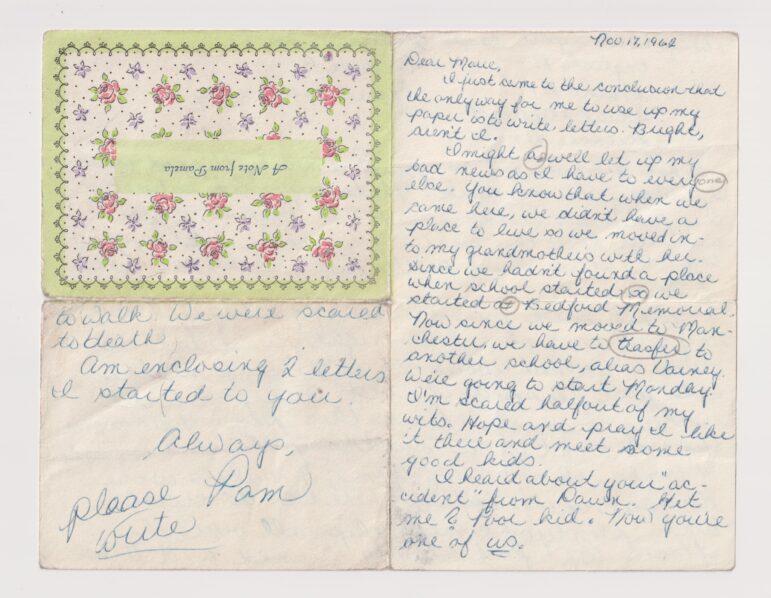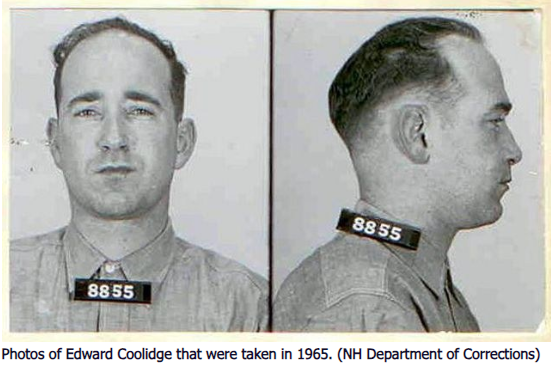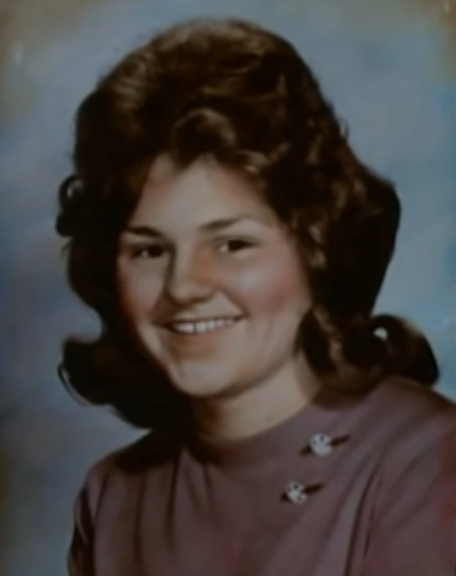
Above, one of the letters returned to Marie Hamel, who had turned over her correspondence with Pamela Mason to police after Pamela was murdered in 1964.
By ANI FREEDMAN, InDepthNH.org
Marie Hamel and Pamela Mason met at Oyster River Middle School in Durham. When Pamela moved to Manchester in 1962, Hamel and their friends were crushed at the thought of their close friend moving 39 miles away, a distance that feels much farther for 14-year-old girls.
They kept in touch by writing letters back-and-forth, sharing about everything from boys, to school, and how deeply Pamela missed her friends back in Durham.
Those letters stopped soon after Pamela moved, when she was tragically murdered.
“That was devastating,” Hamel said over the phone. “It was learning that the world wasn’t the fairytale we’d grown up with.”
Hamel hadn’t seen those letters in nearly 60 years until just a few weeks ago, when the Manchester Police Department finally released them from their evidence archives.
“Even though they’re letters back-and-forth between two 14-year-old girls, it’s a whole part of my life that’s all of the sudden come back,” Hamel said.
It all began with a Facebook post from former Durham resident and professional writer, Rona Maynard. Hamel read Maynard’s post from January of this year, flooded with emotions as Maynard described one of her few memories of Pam in an eighth-grade home economics class.
Hamel commented about the letters between her and Pam, how she wished to read them again, and that the Manchester Police still held them.
Hamel had tried once before to get her letters back. About 10 to 15 years after Pamela’s death, Hamel called the Manchester Police, but felt brushed off. She was promised the letters would be returned to her when the investigation and trial were over.
“I didn’t feel like they were hearing me at all,” Hamel said. She never tried again, until Rep. Rosemarie Rung, D-Merrimack, contacted her.
Rung had seen Hamel’s comment on the Facebook post and responded that she was a state Representative and may be able to help her out.
“You never know how that writing will illicit feelings and memories,” Rung said in an interview. “I feel my role was just as a little catalyst, just to match that reader and writer with the means to bring about what was such an important part of their life.”
Rung immediately got to work, contacting other state Representatives and the Manchester Police Department to get the letters back. Rung asked Rep. Mary Heath, D-Manchester, who is also Ward 4 Alderman, to help facilitate the process.
Heath quickly contacted Chief Allen D. Aldenberg of Manchester Police Department, who she gives the most credit for getting the letters back. Aldenberg contacted the Attorney General to get permission to release the letters, and no other evidence from the case. Heath said Aldenberg’s help was instrumental in giving these women back a piece of their past.
“I’m so grateful that a woman who had a friend a long time ago could really be made whole in her heart to get the letters back that they had shared together,” Heath said over the phone.
In October, Hamel started to get the letters back, just six days after contacting Detective Lieutenant Patrick Houghton at the Manchester Police. She was sent four letters that Pamela had written her, and many more that she had written to Pamela. Hamel suspects there were many more letters that have since been lost, some that she may have never given to the detectives to begin with.
In an email, Houghton said he received the request from Aldenberg and was quick to send Hamel and another former friend of Pamela digital and hard copies of the letters.
“This was the first request for these letters that this administration had received, and we got the letters back to the women within a matter of days following their respective requests,” Houghton wrote. “They had been held in the case file for the investigation, and copies of the letters were made and remain in that case file following the return of the originals to the women over the past weeks.”
Melissa Blache, an intern from Great Bay Community College at the department, was the one to find the letters. According to Houghton, Blache had said, “It was sad to think about these young girls corresponding with one another having no idea about the awful events that were to follow.”
“We were glad to be able to get them these letters back after so many years,” Houghton said in the email. “They dealt with the horrific experience of losing their friend at such a young age all those years ago, and they provided these private letters to the original investigators in hopes of giving some insight into Ms. Mason’s life prior to her murder.”
Pamela Mason was murdered during a blizzard in January 1964. She died from several gunshot and knife wounds. Articles from that year spoke of an ad she placed for her babysitting service. She was last seen entering the car of a man who answered the ad. The man arrested was Edward Coolidge. He was released from prison in 1982 after making parole, according to news accounts from the time.

It was a murder that shook the entirety of New Hampshire, Maynard said over the phone. For her, having known Pam made the tragedy stick with her even more so, as she has continued to write about Pam her whole life.
“It just never dies,” Maynard said.
Maynard has complicated feelings about Pam and her death. They didn’t particularly like each other in school. Maynard envied how Pam and her friends seemed to fit in, while she felt like she didn’t have a place in Durham. But she feels differently now.
“Now that we’re old, we have more compassion, more life experience,” Maynard said over the phone. “I feel tenderness toward them,” she said of Pam and her.
“We never really forget our young selves,” Maynard said. “The strongest emotions we feel are when we are teenagers.”
Having played a role in the retrieval of the letters has impacted Maynard and those teenage emotions.
“It’s quite a feeling to know you’ve made a difference for somebody long ago you didn’t like,” Maynard said, talking about one of Pam’s friends. “You never imagined yourself being kind to that person. When you’re young, it doesn’t occur to you to wonder what the other person might be struggling with in her day.”
Maynard feels that Pam’s memory has been clouded by her murder, but these letters help to bring back a piece of who she was.
“Those letters hold what remains of Pam’s voice,” Maynard said. “Imagine how it must feel to be 74 and reading a letter that your murdered friend wrote 60 years ago. And she is still 14.”
In an email, Hamel quoted some of Pam’s letters. From a letter dated July 24, 1963, Pam wrote, “I have to babysit for my girlfriend’s little nephew today. Surprisingly enough, I’m looking forward to it. He’s a he, almost 2 years old, but real cute and such a good kid.”
Reading words in Pam’s voice again, Hamel remarked, “This reminds me of how kind, friendly and outgoing Pami was. It also reminds me that she had responded to a card looking for a babysitter and when she was picked up for that babysitting job for strangers, she was never seen alive again.”
When Pam first arrived in Manchester, Hamel said she missed her friends dearly. But Hamel knew Pam was capable of making the most of it.
From a letter dated November 17, 1962, Pam wrote to Hamel, “We’re going to start Monday. I’m scared half out of my wits. Hope and pray I like it there and meet some good kids.”
“She had adjusted quickly to the first new school and undoubtedly adjusted well to the second,” Hamel wrote in the email. “My memory of Pam is that she was always quiet, friendly, and everyone liked her.”






